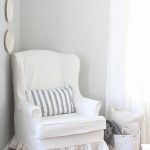
How to Sew a Slipcover for a Wingback Chair
Learn how to sew a slipcover for a wingback chair with this step by step video tutorial.
Servings 1
Cost 5
Equipment
- Sewing machine
Ingredients
- 100% cotton drop cloth
- sewing pins
Instructions
- For this slipcover I used painter’s drop cloth that I bleached (a process you can find on my blog!)
- This is not a quick process. You will want your chair near your sewing machine, so you can continually go back and forth to make sure everything is fitting okay. You never want to pin and sew several seams at one time. Always pin a little, sew it, and return to the chair to pin a little more. Taking care to go slowly will ensure an excellent fit!
- To begin, I made enough piping to get me through the whole project.
- To do this, I sandwiched 6/32″ cotton cord inside a four inch strip of bleached drop cloth. I used a zipper foot to get the needle as close to the cord as possible, without sewing over it.
- Next, I cut and draped all the pieces over the chair. (This will make waaay more sense in the video.) I cut pieces for the outside and inside of the wing, two pieces for the back, two pieces for the arms, two pieces for the front of the arms, two outside lower pieces, a piece for the front apron and a large piece for the front chair back (if that makes any sense at all).
- I totally guesstimated all the sizes of the pieces. Nothing has to be exact. The exactness will come with the pinning and sewing. I started by overlapping the two back pieces and pinning them (right sides together) to the chair back piece.It is really important to keep the chair back piece smooth and tight. It will the most visible in the finished slipcover.
- Following the lines and seams of the original chair, I pinned the outside wing pieces to the back and to the inside wing pieces, which I also pinned to the front of the chair piece.
Have I lost you? It will make sense in the video. - You can see how many pins I used in this process. I wanted to be sure they would follow the lines of the chair, ensuring a nice fit.
I made sure the pins created a line for me to sew along. - While slipcovering I stop several times to be sure everything is still fitting.Sometimes things may appear a bit wonky but might actually turn out when you pull it taut at another seam. And remember that mine looked like it wasn’t going well halfway through, but turned out totally fine!
- I could tell that I wasn’t going to have quite enough bleached drop cloth to finish my project, so I used unbleached drop cloth for the portion that would be hidden underneath the cushion. Notice in the photo below how all the seams of my slipcover are along the original seams of the chair. Use the piece as your guide. This will allow you to slipcover anything.
- After the main portion of the slipcover was finished, I added a ruffle and piping to the bottom edge to finish it off.
- For the cushion, I created an envelope style cover, as opposed to using a zipper. To make the pattern, I traced the shape of the cushion onto the drop cloth, leaving about a half inch on all sides for seam allowance. For the bottom part of the cushion I cut two pieces that would overlap each other for the cushion to fit inside.
- I also cut a long strip that would go around the center of the cushion to join together the top and bottom pieces, with piping sandwiched between. If you are on the fence about trying this, I encourage you to do it! As long as you go slow and check the fit often, you can totally do this.
Notes
How to Slipcover ANY Furniture:
- Follow the original seams and lines of the chair/couch/love seat
- If you are adding piping, use the original chair as your guide. Put it in all the places that the original maker of the chair put it.
- Pin the fabric tightly to the chair
- Use a lot of pins and sew often.